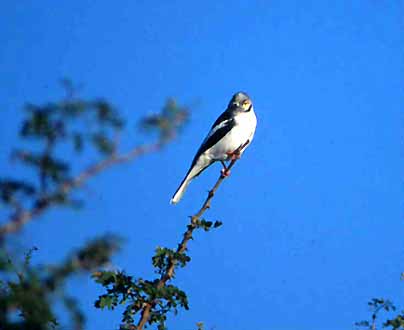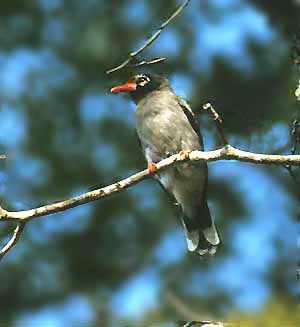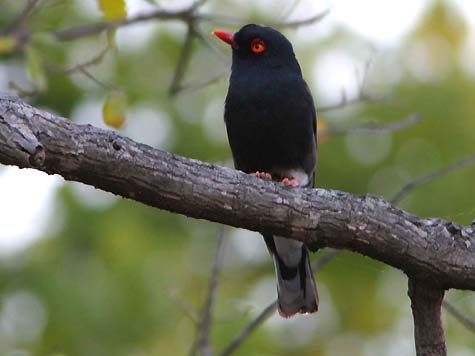| |
HELMETSHRIKES Prionopinae |
- 8 species in sub Saharan Africa
- DR personal total: 3 species (37%), 3 photo'd
|
 Helmetshrikes are a small group of African birds. The typical Prionops helmet-shrikes, like White Helmetshrike
(left), are noisy sociable birds, restlessly traveling through bush or
woodland in parties of a few to two dozen individuals. The feed mainly
among branches and foliage, and I had to grab this shot quickly as they
were constantly moving on. Some of the species breed co-operatively and
roost communally. Helmetshrikes are a small group of African birds. The typical Prionops helmet-shrikes, like White Helmetshrike
(left), are noisy sociable birds, restlessly traveling through bush or
woodland in parties of a few to two dozen individuals. The feed mainly
among branches and foliage, and I had to grab this shot quickly as they
were constantly moving on. Some of the species breed co-operatively and
roost communally.
The taxonomic position of
helmetshrikes was long the subject of debate, with widely different
approaches (e.g., Traylor 1986, Sibley & Ahlquist 1990, Sibley
& Monroe 1990, Keith 1992, Dowsett & Dowsett-Lemaire 1993,
Dickinson 2003). However, the debate was settled recently when DNA
sequencing data became available for most of the species in this and
related families (Fuchs et al. 2004, Reddy et al. 2012). It shows that
among the bush-shrike, helmet-shrike, vanga, batises, wattle-eyes, and
shrike-flycatchers, there are three distinctive clades: (a) the core
bush-shrikes, (b) the batises and wattle-eyes, and (c) the rest of
them. Thus helmet-shrikes, vangas, shrike-flycatchers and allies are
all on the same evolutionary branch, and the branch includes such
far-flung Asian birds as woodshrikes, flycatcher-shrikes, and
philentomas; Reddy et al. (2012). The latter paper proposed that the
helmetshrikes — often considered a separate family — are better
represented as a subfamily of the larger vangid radiation, within the
family Vangidae.
|
 Some species have a circular fleshy wattle around the eye, and an example is shown by the Chestnut-fronted Helmet-shrike
(right) of coastal east Africa. It is often found it flocks with other
birds, acting tit-like as it forages along branches or clings to
trunks. The eye-wattle recalls the unique African wattle-eyes which are
placed in a separate family, along with batises, the Platysteiridae
(Zimmerman et al. 1996; Fuchs et al. 2004). Some species have a circular fleshy wattle around the eye, and an example is shown by the Chestnut-fronted Helmet-shrike
(right) of coastal east Africa. It is often found it flocks with other
birds, acting tit-like as it forages along branches or clings to
trunks. The eye-wattle recalls the unique African wattle-eyes which are
placed in a separate family, along with batises, the Platysteiridae
(Zimmerman et al. 1996; Fuchs et al. 2004).
Among the 8 Prionops helmet-shrikes, two are rare enough to be classified as threatened. The obscure Gabela Helmet-shrike P. gabela,
known only from a small area of forest & thicket near Gabela on the
scarp of Angola, is considered Endangered. Yellow-crested Helmet-Shrike
P. alberti is a real enigma of the mountains of eastern Congo.
Almost nothing is known about this spectacular bird that appears on my
"top 50" best birds of the world. |
 All
of the Prionops species have striking plumage patterns (often
black-and-white), and many have colorful bills or eye-wattles. Looking
at field guides, I always wanted to see Retz's Helmet-Shrike because it
looked so cool. In 2005 we got to see a pair at Xaro Camp on the
Okavango River in northern Botswana. Retz's Helmet-Shrike (left) is indeed a classy bird. All
of the Prionops species have striking plumage patterns (often
black-and-white), and many have colorful bills or eye-wattles. Looking
at field guides, I always wanted to see Retz's Helmet-Shrike because it
looked so cool. In 2005 we got to see a pair at Xaro Camp on the
Okavango River in northern Botswana. Retz's Helmet-Shrike (left) is indeed a classy bird. |
Photos: The White Helmetshrike Prionops plumatus was photographed in Kruger Nat'l Park, South Africa, on 28 July 1996. The Chestnut-fronted Helmetshrike P. scopifrons was in the Sokeke Forest of coastal Kenya, 28 Nov 1981. The Retz's Helmetshrike P. retzii was at Xaro Lodge in northern Botswana on 23 July 2005. All photos © D. Roberson; all rights reserved.
Family Book: 
Harris, T., and K. Franklin. 2000. Shrikes & Bush-Shrikes. Princeton Univ. Press, Princeton, N.J.
This
is a very attractive offering in the Princeton bird families series.
Tony Harris wrote the text; Kim Franklin did the plates. It has the
familiar layout of plates altogether in the front, with range maps and
i.d. summary, and detailed species accounts in the back. It looks well
researched and has a good bibliography. I very much enjoyed the
full-page spreads, with black-and-white sketch, on each genus in the
groups covered, that highlights the introduction. There is a lot of
discussion of taxonomy but, unfortunately, the authors chose to follow
the Sibley & Monroe (1990) approach of only two families: shrikes
[Laniidae] and bush-shrikes [Malaconotidae]. All of the batises,
wattle-eyes, helmet shrikes, and such things as flycatcher-shrikes,
wood-shrikes, and philentomas, are thrown into the latter family. New
research does not support this approach. As it turns out, the true
shrikes are not the closest relatives to the rest of this set (e.g.,
Barker et al. 2004), so even the premise of this book proves false.
Further, vangas (not included in this book) are closely related to the
rest of the group. Indeed, it appears that the flycatcher-shrikes are
vangas, and that helmet-shrikes are very closely related to vangas. The
text also suffers from the author's use of the "Species Recognition
Concept" as his definition for species; fortunately, in practice, in
works rather like the tried-and-true "Biological Species Concept." Yet
both in its language and in its reliance on DNA hybridization evidence
(Sibley & Ahlquist 1990), this book has the unfortunate status of
being out-of-date taxonomically much more quickly than would be
anticipated. That having been said, the species accounts, maps, and
paintings for the species that are included all are very good. This is
a well-written book with attractive paintings. It is great to have a
world overview of the species that are included, even if they do not
hang together as a group. One major annoyance: citations in the text
are small-print superscript numbers. A list of these numbers is in the
back of the book, but the list does not give the full citation. Rather,
citation number 732 is "Emlen 1979." One then has to go check the
bibliography to locate the full citation to Emlen's note in Scopus on
fiscal shrikes. This is an entirely unnecessary double effort for the
reader, and should have been fixed by the publisher (just number the
bibliography if you use this tactic; see Dickinson 2003 for an example
of the proper way to do this). Despite all these criticisms, it IS a
very attractive publication and quite useful in many ways. So I give it
3 (of 5) stars despite its limitations. The basic, underlying
information about each taxa, and the attractive plates, make up for a
lot.
Literature cited:
Barker,
F.K., A. Cibois, P. Schikler, J. Feinstein, and J. Cracraft. 2004.
Phylogeny and diversification of the largest avian radiation. Proc.
Nat. Acad. Sci. 101: 11040-11045.
Birdlife
International. 2000. Threatened Birds of the World. Barcelona &
Cambridge, U.K., Lynx Edicions & Birdlife International.
Brown,
L. H., E. K. Urban, and K. Newman, eds. 1982. The Birds of Africa. Vol.
1. Academic Press, London. Keith, S., E. K. Urban, and C. H. Fry, eds.
1992. The Birds of Africa. Vol. 4. Academic Press, London.
Dickinson,
E.C., ed. 2003. The Howard & Moore Complete Checklist of the Birds
of the World. 3d ed. Princeton Univ. Press, Princeton, N.J.
Dowsett, R. J., and F. Dowsett-Lemaire. 1993. "Comments on the taxonomy of some Afrotropical bird species," pp. 232-389 in
A Contribution to the Distribution and Taxonomy of Afrotropical and
Malagasy Birds (R. J. Dowsett & F. Dowsett-Lemaire, eds.). Tauraco
Res. Rpt. 5. Tauraco Press, Liége.
Fuchs,
J., R.C.K. Bowie, J. Fjeldså, and E. Pasquet. 2004. Phylogenetic
relationships of the African bush-shrikes and helmet-shrikes
(Passeriformes: Malaconotidae). Mol. Phylog. Evol. 33: 428-439.
Reddy,
S., A. Driskell, D.L. Rabosky, S.J. Hackett, and T.S. Schulenberg.
2012. Diversification and the adaptive radiation of the vangas of
Madagascar, Proc. Royal Soc. B 279, 2062-2071.
Schulenberg, T.S. 2003. "The Radiations of Passerine Birds of Madagascar," pp. 1130-1134 in S.M. Goodman & J.P. Benstead (eds.) The Natural History of Madagascar.
Sibley,
C. G., and J. E. Ahlquist. 1990. Phylogeny and Classification of Birds:
A Study in Molecular Evolution. Yale Univ. Press, New Haven, CT.
Sibley,
C. G., and B. L. Monroe, Jr. 1990. Distribution and Taxonomy of Birds
of the World. Yale Univ. Press, New Haven, CT.
Traylor,
M. A. 1986. "Platysteiridea," "Muscicapidae," et al. in Check-list of
Birds of the World (E. Mayr & G. W. Cotrell, eds). Vol. 11. Harvard
Univ. Press, Cambridge, MA.
Zimmerman, D. A., D. A. Turner, and D. J. Pearson. 1996. Birds of Kenya and northern Tanzania. Christopher Helm, London.
|
|
|

 All
of the Prionops species have striking plumage patterns (often
black-and-white), and many have colorful bills or eye-wattles. Looking
at field guides, I always wanted to see Retz's Helmet-Shrike because it
looked so cool. In 2005 we got to see a pair at Xaro Camp on the
Okavango River in northern Botswana. Retz's Helmet-Shrike (left) is indeed a classy bird.
All
of the Prionops species have striking plumage patterns (often
black-and-white), and many have colorful bills or eye-wattles. Looking
at field guides, I always wanted to see Retz's Helmet-Shrike because it
looked so cool. In 2005 we got to see a pair at Xaro Camp on the
Okavango River in northern Botswana. Retz's Helmet-Shrike (left) is indeed a classy bird. Helmetshrikes are a small group of African birds. The typical Prionops helmet-shrikes, like White Helmetshrike
(left), are noisy sociable birds, restlessly traveling through bush or
woodland in parties of a few to two dozen individuals. The feed mainly
among branches and foliage, and I had to grab this shot quickly as they
were constantly moving on. Some of the species breed co-operatively and
roost communally.
Helmetshrikes are a small group of African birds. The typical Prionops helmet-shrikes, like White Helmetshrike
(left), are noisy sociable birds, restlessly traveling through bush or
woodland in parties of a few to two dozen individuals. The feed mainly
among branches and foliage, and I had to grab this shot quickly as they
were constantly moving on. Some of the species breed co-operatively and
roost communally.  Some species have a circular fleshy wattle around the eye, and an example is shown by the Chestnut-fronted Helmet-shrike
(right) of coastal east Africa. It is often found it flocks with other
birds, acting tit-like as it forages along branches or clings to
trunks. The eye-wattle recalls the unique African wattle-eyes which are
placed in a separate family, along with batises, the Platysteiridae
(Zimmerman et al. 1996; Fuchs et al. 2004).
Some species have a circular fleshy wattle around the eye, and an example is shown by the Chestnut-fronted Helmet-shrike
(right) of coastal east Africa. It is often found it flocks with other
birds, acting tit-like as it forages along branches or clings to
trunks. The eye-wattle recalls the unique African wattle-eyes which are
placed in a separate family, along with batises, the Platysteiridae
(Zimmerman et al. 1996; Fuchs et al. 2004). 